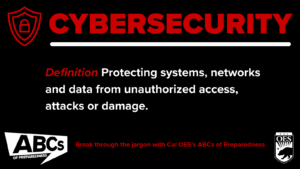
Data breaches, malware, phishing, and social engineering are not just words, but examples of cyber threats that could compromise vital services fundamental to our daily lives.
The California Governor’s Office of Emergency Services (Cal OES), along with its California Cybersecurity Integration Center (Cal-CSIC), is at the forefront of mitigating cyber threats.
To raise awareness on cyber threats and their mitigation efforts, October is recognized as Cybersecurity Awareness Month. This campaign aims to raise awareness about digital security and empower everyone to protect their personal data from digital crime.

Here are 10 tech safety tips you can implement now:
1) Use Strong and Unique Passwords: Create strong, complex passwords for your online accounts, and avoid using the same password for multiple accounts. Consider using a password manager to generate and securely store your passwords.
2) Enable Multi-Factor Authentication (MFA): Whenever possible, enable MFA for your online accounts. MFA adds an extra layer of security by requiring you to provide a second form of verification, such as a code sent to your mobile device.
3) Keep Software and Devices Updated: Regularly update your operating system, software, and applications. Cybercriminals often exploit vulnerabilities in outdated software.
4) Beware of Phishing: Be cautious of unsolicited emails, messages, or calls asking for personal information or credentials. Verify the sender’s identity before sharing any sensitive information.
5) Use Antivirus Software: Install reputable antivirus and anti-malware software on your devices and keep it up to date. This can help detect and prevent malware infections.
6) Secure Your Wi-Fi: Change default router passwords, use strong encryption (WPA3 or WPA2opens in a new window), and create a unique network name. Regularly update your router’s firmware.
7) Regularly Back up Data: Back up important data to an external device or a secure cloud service. This can help recover your data in case of ransomware attacks or hardware failures.
8) Monitor Your Financial Accounts: Regularly review your bank and credit card statements for unauthorized transactions. Report any suspicious activity immediately.
9) Use Secure Websites: Look for “https://” in the website’s URL and a padlock icon in the browser’s address bar when entering sensitive information online.
10) Stop and Think Before You Click the Link: Don’t click on suspicious links, download unknown attachments, or trust unexpected requests for money or personal information. Be skeptical.
Stay vigilant: By using the tips above and proactively protecting your online presence, you can reduce your vulnerability to cyber threats and help maintain a safer digital environment for all.




Resources:
California Cybersecurity Integration Center
California Department of Technology
National Cybersecurity Alliance
October is Cybersecurity Month: Practice These Tech Safety Tips
Cybersecurity and Your Online Safety with Advice from Cal-CSIC Commander Jonathan Nunez

Related Content:
